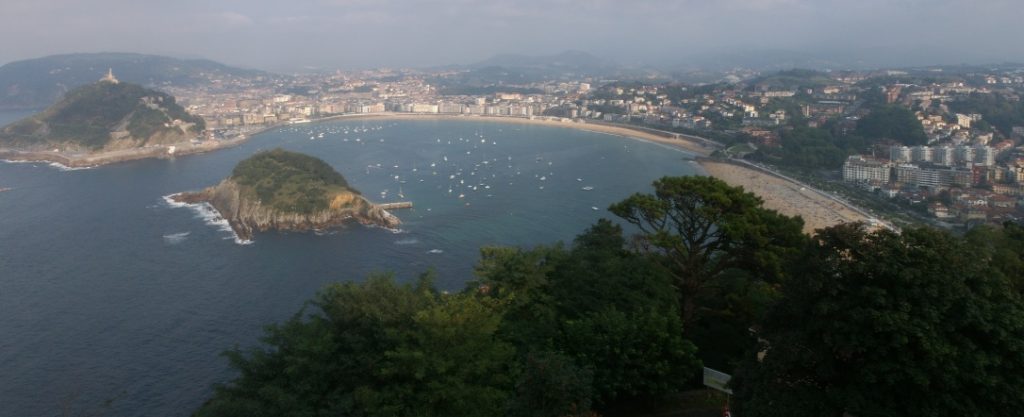Today, Donostia is a thriving metropolitan city that is a draw for tourists from around the world. Picturesque beaches and an awesome food scene are just a few of the things that make Donostia a must visit. But, with any such city, these modern trappings hide a long history, one which often saw Donostia in the crossfire of conflict that resulted in, more than once, the near-destruction of the city.
- The first documented reference to Donostia-San Sebastián, referred to as Sanctum Sebastianum, was in 934 by the monastery of San Millán de la Cogolla. In 1014, the king Sancho el Mayor of Nafarroa gave the monastery Sancti Sebastiani to the monastery at Leire. The Basque name of the city is a compound of done ‘saint, holy’ and the name of the saint Sebastian. Thus, Done Sebastiani evolved to Donostia. Donostia, as a name, appears in poems by Perez de Lazarraga in 1567.
- Donostia as a formal town was founded some time around 1180. The actual date has been lost to history, but it seems clear that it was Sancho VI the Wise of Nafarroa who granted the privilege of founding a town. Donostia was the first village founded in what would ultimately become the province of Gipuzkoa.
- In 1200, the town was conquered by Castilla, cutting Nafarroa off from the sea. However, in 1265, Nafarroa was given permission to use the port. Somehow, the city avoided the War of the Bands that ravaged much of Gipuzkoa and, in fact, Donostia only officially became part of the province in 1459.
- Throughout its history, Donostia has been ravaged by fires. In the Middle Ages, fires occurred in 1278, 1338, 1361, 1397, 1433, 1483, 1489, 1496, and 1512. However, of these, it was the fire of 1489 that was particularly devastating. On January 8 of that year, the town essentially burnt to the ground. The town took advantage of the destruction by rebuilding with stone instead of timber. Another catastrophe took place on December 14, 1575: when lightning struck the powder magazine located near the top of the La Mota castle, 25 barrels of gunpowder blew up, falling on the city and causing a series of explosions and fires – literally raining destruction. The same thing happened again in 1688, again causing widespread damage to the city.
- Starting in the 16th century, when the border between what would become France and Spain began to harden, Donostia saw greater strategic importance. Being the biggest city close to the border, it became known as the “Key to France.” This is in addition to the commercial importance the city already enjoyed. Indeed, Donostia had the royal privilege of being the port where half of the merchandise brought into Gipuzkoa had to be unloaded. The strategic location of Donostia meant that many kings and queens passed through and often stayed in the city, adding to its reputation.
- In 1512, the city found itself in the middle of fighting between Nafarroa and its ally France against the forces of Ferdinand the Catholic. The French, after burning several nearby towns, besieged the city. With the help of reinforcements from Ferdinand and later Bizkaia and Gipuzkoa, the city expelled the French. However, the rest of the 16th century saw further hardship. Many sailors from Donostia and the surrounding towns had died in battle, reducing the number of experienced seamen that could fish cod and hunt whales. And, in 1597, the whole region was ravaged by plague, further harming the economic situation of the city and province.
- The city fell into French hands not once, but twice, in the ensuing years. First, in 1719, the French Duke of Berwick took the city, which the French held for two years. Again in 1808, Napoleonic forces captured the city. Only a few years later, in 1813, British and Portuguese forces besieged the city to remove the French occupiers, but they had little concern for the inhabitants of the city and it again was burnt to the ground. La Tamborrada commemorates the city’s resistance against Napoleon.
- Donostia became the permanent capital of Gipuzkoa in 1854. Before that, it had rotated between Donostia, Tolosa, Azpeitia, and Azkoitia, depending on where the Junta – the governing council – met. In the first half of the 1800s, Tolosa became the capital of the province before Donostia was named the permanent capital.
Primary sources: Barrena Osoro, Elena [et al.]. Donostia / San Sebastián. Historia. Auñamendi Encyclopedia. Available at: https://aunamendi.eusko-ikaskuntza.eus/en/donostia-san-sebastian-historia/ar-45908/; Auñamendi Entziklopedia. Donostia / San Sebastián. Auñamendi Encyclopedia . Available at: https://aunamendi.eusko-ikaskuntza.eus/en/donostia-san-sebastian/ar-36359/; San Sebastián, Wikipedia



